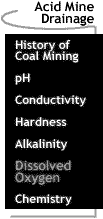

 |
Acid Mine Drainage: Dissolved Oxygen There are two main sources of
dissolved oxygen in stream water: the atmosphere and photosynthesis. Waves and tumbling
water mix air into the water where oxygen readily dissolves until saturation occurs.
Oxygen is also introduced by aquatic plants and algae as a byproduct of photosynthesis. Photo: Courtesy of Kenneth E. Rastall There are two main sources of
dissolved oxygen in stream water: the atmosphere and photosynthesis. Waves and tumbling
water mix air into the water where oxygen readily dissolves until saturation occurs.
Oxygen is also introduced by aquatic plants and algae as a byproduct of photosynthesis. Photo: Courtesy of Kenneth E. Rastall
Dissolved Oxygen / Greatest Amount of Oxygen x 100 = % Saturation Oxygen is essential for fish, invertebrate, plant, and aerobic bacteria respiration. Dissolved oxygen levels below 3 ppm are stressful to most aquatic organisms. Levels below 2 or 1 ppm will not support fish. Fish growth and activity usually require 5--6 ppm of dissolved oxygen. Low dissolved oxygen levels indicate an excessive demand on the oxygen of the system. The build up of organic material from human activities is one source of oxygen depletion. Microorganisms in the stream consume oxygen as they decompose sewage, urban and agricultural runoff, and discharge from food-processing plants, meat-packaging plants, and dairies. Natural organic materials, such as leaves, accumulate in the stream and create an oxygen demand as they decompose. Some pollutants, such as acid mine drainage, produce direct chemical demands on oxygen in the water. Dissolved oxygen is consumed in the oxidation-reduction reactions of introduced chemical compounds, such as nitrate (NO31-) and ammonia (NH41+), sulfate (SO42-) and sulfite (SO32-), and ferrous (Fe2+) and ferric (Fe3+) ions. [ Acid
Mine Drainage: History of Coal Mining /
pH /
Conductivity / [ Sewage ] [ Agriculture ] [ Dredging ] [ Home ] [ Teacher Pages ] [ Modules & Activities ] |
HTML code by Chris Kreger
Maintained by ETE Team
Last updated November 10, 2004
Some images © 2004 www.clipart.com
Privacy Statement and Copyright © 1997-2004 by Wheeling Jesuit University/NASA-supported Classroom of the Future. All rights reserved.
Center for Educational Technologies, Circuit Board/Apple graphic logo, and COTF Classroom of the Future logo are registered trademarks of Wheeling Jesuit University.